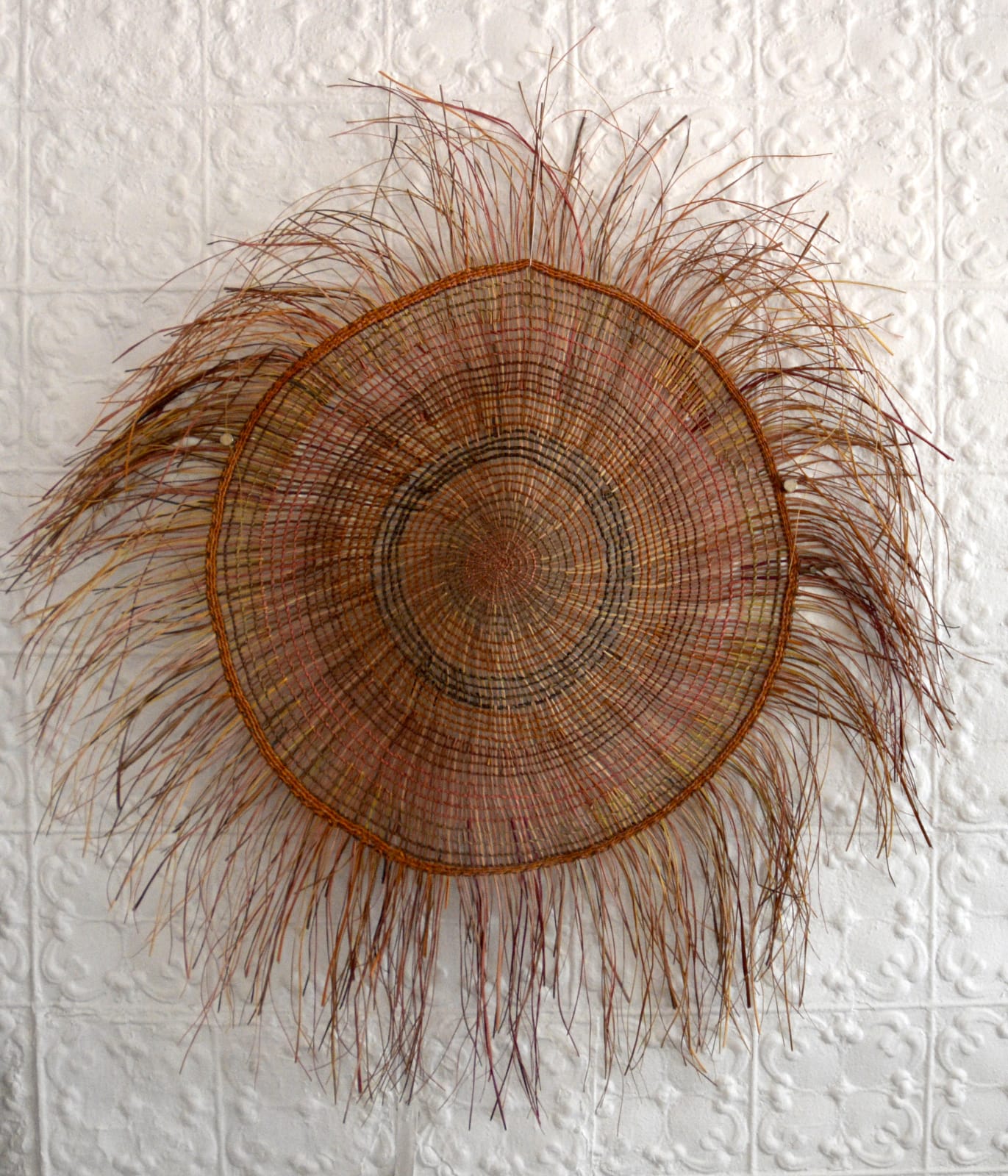Leanne Nayilibidj
Marebu (Woven Mat), 2022
pandanus fibre and natural dyes
85 x 85 cm
2560-22
Marebu is the general Kunwinjku term for woven mats. These were traditionally valuable items. Some were used as working surfaces, others were worn and others used during ceremonial occasions. Traditionally...
Marebu is the general Kunwinjku term for woven mats. These were traditionally valuable items. Some were used as working surfaces, others were worn and others used during ceremonial occasions.
Traditionally these items would have been woven from plain pandanus, but today they are usually coloured with natural dyes. It is possible that the use of natural dyes was encouraged by missionaries, influenced by what they had seen on Pacific islands. However it would have been local women, with their knowledge of local plants and bush medicines, who would have carried out the experimentation necessary for such a rich dye repertoire.
The most common dyes include:
Yellow-orange: Mandjurndum (the bright orange roots of the Pognolobus reticulatus bush)
Brown: Wirdilwirdil (the red bulb of Haemadorum breviculae grass)
Green: The growing shoot of the pandanus itself (Pandanus spirals) boiled with the ashes of pandanus leaves
Purple-pink: Windilk (the seeds of the Haemodorum coccineum plant, related to Kangaroo Paw)
Grey-Black; Manbedde (the leaves of the quinine bush, Petalostigma pubescens)
Naw Marebu nakka nakimuk mat kabirrimarnbun. Daluhdaluk kabirrire kunngobarn (manbelk) kabirrmang dja kundulk manbu mandjangal kabirrikan kabirrikardmang manbu kunngobarn kahdjabdi manekke kabirrimang kabirridurrkmang wanjh kabirrikan kured. Kabirriyirrme rowk kabirrimang drum badjdjukkali naw nakimuk kabirrikinje mandjurndum dorrengh kabirrikinje yika widilwidil dorrengh. Wanjh kabirridakurrme kore kurrungbang kadato kabukman Wanjh kabirrimarnbun naw marebu kunbid bedberre. Kabirridejdjingmang nayahwurd kabirrihdjale kabirrikimukwon nakimuk marebu kabirrimarnbun.
Traditionally these items would have been woven from plain pandanus, but today they are usually coloured with natural dyes. It is possible that the use of natural dyes was encouraged by missionaries, influenced by what they had seen on Pacific islands. However it would have been local women, with their knowledge of local plants and bush medicines, who would have carried out the experimentation necessary for such a rich dye repertoire.
The most common dyes include:
Yellow-orange: Mandjurndum (the bright orange roots of the Pognolobus reticulatus bush)
Brown: Wirdilwirdil (the red bulb of Haemadorum breviculae grass)
Green: The growing shoot of the pandanus itself (Pandanus spirals) boiled with the ashes of pandanus leaves
Purple-pink: Windilk (the seeds of the Haemodorum coccineum plant, related to Kangaroo Paw)
Grey-Black; Manbedde (the leaves of the quinine bush, Petalostigma pubescens)
Naw Marebu nakka nakimuk mat kabirrimarnbun. Daluhdaluk kabirrire kunngobarn (manbelk) kabirrmang dja kundulk manbu mandjangal kabirrikan kabirrikardmang manbu kunngobarn kahdjabdi manekke kabirrimang kabirridurrkmang wanjh kabirrikan kured. Kabirriyirrme rowk kabirrimang drum badjdjukkali naw nakimuk kabirrikinje mandjurndum dorrengh kabirrikinje yika widilwidil dorrengh. Wanjh kabirridakurrme kore kurrungbang kadato kabukman Wanjh kabirrimarnbun naw marebu kunbid bedberre. Kabirridejdjingmang nayahwurd kabirrihdjale kabirrikimukwon nakimuk marebu kabirrimarnbun.
